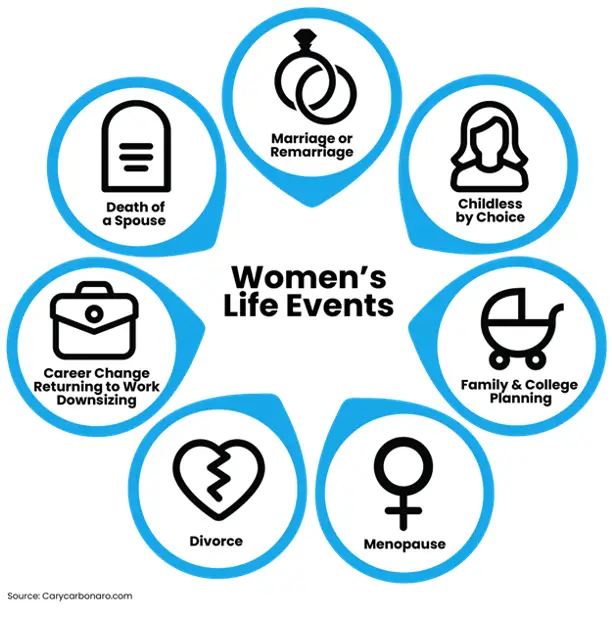Broadway is self-empowering its female protagonists. By asking these 18 questions, we can do the same for our female clients.
By Car Carbonaro | Read Orginal Posting Here
Editor’s note: Cary Carbonaro is a longtime columnist with Rethinking65. To read more of her articles, click here:
“Fairy tales are more than true — not because they tell us that dragons exist, but because they tell us that dragons can be beaten.” Margaret Atwood
Fairy tales have long been a part of cultural storytelling, often conveying traditional gender roles and expectations. The classic narratives frequently portray women as passive characters who rely on male saviors for their happiness and fulfillment. Think Cinderella, Sleeping Beauty and Snow White. Often steeped in cultural and historical contexts, fairy tales perpetuate the idea that a woman’s ultimate fulfillment lies in marriage and being cared for by a man, which does not account for non-traditional relationships and modern societal changes.
Women grow up with these messages and they continue to be part of their socialization. Yet this traditional portrayal can influence how women perceive their roles and independence, potentially limiting their sense of agency and reinforcing outdated gender norms.
The world is changing, we are changing. We have co-habituating couples who are not married and same-sex couples, yet fairy tales often only address traditional roles.
Here’s a breakdown of what fairy tales traditionally teach us about being independent women, and how modern interpretations challenge these lessons.
Traditional Messages on Independence
- Dependency on Rescuers: As mentioned earlier, classic fairy tales like “Cinderella,” “Sleeping Beauty,” and “Snow White” often depict female protagonists as passive characters who need rescuing by a prince or a male hero. These stories suggest that a woman’s happiness and success are reliant on male or partner intervention.
- Virtue and Patience: Many fairy tales emphasize virtues like kindness, patience and obedience. Women are often rewarded by external forces rather than their own actions. This implies that women should wait for rescue or reward rather than taking action themselves.
- Conformity to Traditional Roles: Characters in these stories frequently conform to traditional gender roles. The ideal woman is often portrayed as beautiful, kind and submissive, suggesting that conforming to these roles is necessary for a happy ending.
Modern Interpretations and Subversions
- Active Protagonists: Modern retellings and interpretations of fairy tales often feature female protagonists who are active and resourceful. For instance, characters like Elsa from “Frozen” and Merida from “Brave” take control of their destinies, promoting independence and self-reliance.
- Challenging Stereotypes: Contemporary fairy tales and adaptations challenge traditional gender stereotypes. These stories often feature women who are brave, intelligent and capable leaders. They encourage readers to see independence as a valuable trait.
- Empowerment and Self-Discovery: Stories like “Beauty and the Beast” can be interpreted as narratives of self-discovery and personal growth. Belle’s love for books and her ability to see beyond appearances highlight inner strength and independence.
Mixed Messages
- Marriage as a Reward: Even in more modern adaptations, the “happily ever after” often still involves marriage. This suggests that ultimate fulfillment for women is found in a romantic relationship.
- Balance of Traits: Some fairy tales suggest that a balance of independence and traditional virtues is ideal. Characters might need to be both kind and assertive, both beautiful and brave. This implies that independence should be tempered with traditional qualities.
Lessons for Independence
- Self-Reliance: Fairy tales with strong, independent female characters teach the value of self-reliance and the importance of taking control of one’s destiny.
- Courage and Resilience: Stories with adventurous and brave heroines promote courage and resilience as essential qualities for overcoming obstacles and achieving goals.
- Critical Thinking: Modern interpretations encourage readers to question traditional narratives and think critically about the roles and expectations placed on women.
Broadway’s Take
Several Broadway shows emphasize female empowerment and independence, each with unique narratives and powerful messages. All the shows resonate with contemporary audiences by challenging outdated norms and celebrating the strength and resilience of women.
‘Once Upon a One More Time’
This musical uses the songs of Britney Spears to tell a modernized fairy tale centered on female empowerment. It features classic characters like Cinderella and Snow White, who, through the course of the story, learn to challenge traditional gender roles and embrace their independence.
Songs like “…Baby One More Time,” “Stronger” and “Toxic” are woven into a narrative that sees the princesses rejecting the need for male saviors. Instead, they charge of their own stories. The music even includes my favorite book, Betty Friedan’s “The Feminine Mystique.” It also questioned the “happily ever after” theme. And in a twist, each prince was the same guy in every fairy tale.
‘Six’
This musical reimagines the lives of the six wives of Henry VIII, presenting them as strong, independent women who tell their own stories. Rather than focusing on their relationships with Henry, the show highlights their individual strengths and resilience through a pop-concert format. The show emphasizes themes of sisterhood and self-determination.
‘9 to 5: The Musical’
Based on the 1980 film, this show tells the story of three women who take control of their workplace, challenging the male-dominated environment and advocating for better conditions and respect. With music by Dolly Parton, it’s a celebration of female camaraderie and empowerment. “9 to 5: The Musical” underscore the importance of solidarity in overcoming systemic challenges.
‘The Color Purple’
Adapted from Alice Walker’s novel, this musical follows the life of Celie, an African-American woman who overcomes immense adversity and oppression. The story spans several decades, portraying Celie’s journey from suffering to self-discovery and empowerment. The show is supported by a blend of jazz, gospel, and blues music.
‘Beautiful: The Carole King Musical’
This show chronicles the rise of singer-songwriter Carole King. It showcases her struggle to break into the music industry and her journey to becoming a successful solo artist. “Beautiful” highlights King’s resilience and determination to succeed in a male-dominated field.
‘Legally Blonde: The Musical’
Adapted from the film, this musical tells the story of Elle Woods, who defies stereotypes and expectations by excelling at Harvard Law School. Her journey of self-empowerment proves that staying true to oneself while pursuing ambitious goals can lead to success.
‘Hairspray’
This musical follows Tracy Turnblad, a teenager who challenges societal norms about beauty and body image. Tracy’s determination to become a dance show star and her advocacy for racial integration make her a symbol of self-confidence and social change.
‘& Juliet’
“& Juliet” reimagines the classic tale of Romeo and Juliet, asking what if Juliet’s story didn’t end with Romeo’s death. The musical flips the script by focusing on Juliet as she embarks on a journey of self-discovery and empowerment. Set to a pop soundtrack, it features hits by Max Martin and includes songs by Britney Spears, Katy Perry and the Backstreet Boys. “& Juliet” explores themes of independence, self-worth and female agency. Juliet refuses to let her life be defined by tragedy or by the men around her.
‘Suffs’
This Broadway musical about the women’s suffrage movement in the U.S. focuses on the events leading to the 19th amendment in 1920. Created by Shaina Taub, the show centers on suffragist and feminist Alice Paul. The musical addresses generational, racial and ideological divides within the movement. “Suffs” also blends encourages reflection on past struggles for equality and ongoing advocacy for justice.
Questions Advisors Should Be Asking
By examining these stories and their evolution, we can better understand the complex ways in which cultural narratives shape our perceptions and our clients’ perceptions of gender roles and independence. As these tales continue to be reimagined, they offer valuable lessons that can inspire future generations to embrace their own strength and autonomy. Here are some questions financial advisors can ask themselves:
Understanding Client Narratives and Expectations
Identifying Influences
- How might my clients’ expectations for a ‘happily ever after’ be influenced by cultural narratives or fairy tale ideals?
- Do I notice any recurring themes or “fairy-tale beliefs” in my clients’ financial goals or expectations (e.g., effortless wealth, sudden windfalls or a perfect retirement)?
Addressing Unrealistic Expectations
- How do I address unrealistic or overly optimistic financial expectations without discouraging my clients?
- Am I equipped to help clients differentiate between achievable goals and idealized outcomes influenced by fairy tale narratives?
Creating Realistic Financial Plans
- How can I help my clients develop a realistic understanding of the challenges and trade-offs involved in achieving their financial goals?
- What strategies can I use to help clients build resilience and adaptability in their financial plans, preparing them for potential setbacks or changes?
Reflecting on Personal Biases and Assumptions
Challenging Personal Beliefs
- Do I have any personal beliefs or biases influenced by cultural narratives or fairy tales that might affect how I advise clients?”
- How can I remain objective and focused on the realities of financial planning while being empathetic to my clients’ hopes and dreams?
Avoiding Oversimplification
- Am I inadvertently oversimplifying complex financial realities by presenting overly optimistic or “fairy-tale” solutions to my clients?
- How can I ensure that I am providing a balanced perspective that includes both opportunities and risks?
Educating and Empowering Clients
Promoting Financial Literacy
- How can I use the idea of “happily ever after” to engage clients in conversations about the importance of financial literacy and realistic planning?
- What educational tools or resources can I offer to help clients understand the importance of setting practical and achievable financial goals?
Encouraging Long-Term Thinking
- How can I encourage clients to think beyond short-term gains and focus on sustainable long-term financial health?
- What narratives or examples can I use to illustrate the importance of ongoing financial education and adaptation to changing circumstances?
Building Trust and Open Communication
Fostering Honest Dialogue
- How do I create a safe space for clients to share their true hopes and fears, beyond the “happily-ever-after” ideal?
- What questions can I ask to uncover underlying concerns or unrealistic expectations that may not be immediately apparent?
Balancing Hope with Realism
- How can I balance fostering hope and optimism in my clients with providing a realistic and practical approach to financial planning?
- How do I ensure that I am not dismissing my clients’ dreams while still guiding them towards feasible financial strategies?




